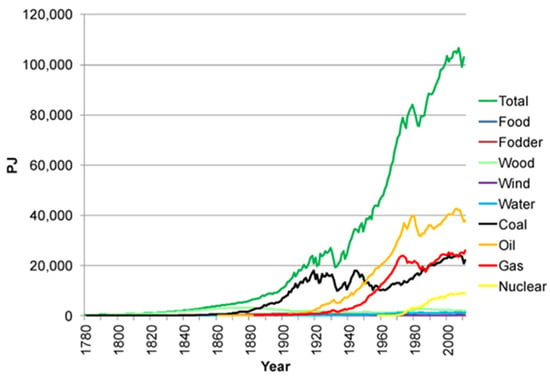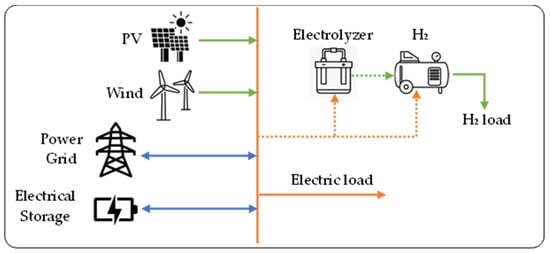Global decarbonization efforts are gaining momentum in response to the urgent need to address climate change and transition towards a sustainable, low/zero-carbon future. Reducing or eliminating carbon dioxide (CO
2) emissions from various sources, particularly those associated with human activities is key to sustainable decarbonization. Key strategies include renewable energy adoption, improvements in energy efficiency, electrification, carbon capture and storage, afforestation and reforestation, circular economy, policy, and regulation [
1].
Numerous studies were conducted on the subject of hydrogen’s role in the energy transition. Kovac et. al. recently reviewed the progress of hydrogen technologies and their application in both emerging and developed countries [
3]. Similarly, Yue et al. conducted a detailed review of the current progress of and outlook for hydrogen technologies, particularly related to power systems for generation and storage. Additionally, techno-economic analysis of such technologies was conducted to show the critical impact of cost, efficiency and durability [
4]. Recent updates on the hydrogen economy were reviewed along with case studies of applying green hydrogen in transportation, industry, and power generation. The authors demonstrated that using green hydrogen in a combined cycle gas turbine power plant can result in significant CO
2 emission reductions [
5]. Recent studies also provided a technological and geopolitical perspective on the role of green and blue hydrogen in the energy transition. The energy losses associated with the hydrogen supply chain and the significance of international standards and cost targets in enabling a hydrogen economy were emphasized [
6,
7]. A systematic review of the literature was recently reported, with a focus on the role of end users in the increased uptake of energy transition technologies [
8]. Individual clean hydrogen case studies for different countries were also reported in which the authors provided prevalent scenarios and expected outcomes for different regions (Japan [
9]; Africa and Europe [
10,
11]; China [
12]; Germany [
13]; Russia [
14]; Australia [
15]; the Global South [
16]; Qatar [
17]; South America [
18]; the Middle East [
19]; Mexico [
20]; and Canada [
21]). A number of review studies were also conducted on challenges and opportunities for innovation in hydrogen-related technologies [
22,
23,
24], with particular focus on production [
25,
26,
27], storage [
28,
29,
30], distribution [
31,
32], grid integration [
33,
34], and utilization [
35,
36].
2. Historical Energy Transitions
The historical energy transition over the past 200 years has been marked by significant shifts in primary energy sources and technological advancements [
37]. The timeline below highlights key phases in this transition (
Figure 1).
In the pre-industrial era (before 1800 A.D.), human societies relied predominantly on traditional biomass, such as wood and crop residues, for cooking, heating, and basic energy needs [
38]. Water and wind power were occasionally utilized for mechanical processes. However, the advent of fossil fuels began in the 18th and 19th centuries. Particularly, the industrial revolution marked a major shift with the widespread use of coal as a primary energy source. Steam engines fueled by coal revolutionized transportation, manufacturing, and agriculture. Then, the rise of oil and gas began in late 19th century. The discovery of oil in the late 19th century and the subsequent development of the oil and gas industry led to a transition away from coal. The internal combustion engine transformed transportation, and oil and natural gas became key sources for heating and electricity generation [
39].
Figure 1. Historical global energy transitions [
40]: Energy consumption profile of each primary energy resource from year 1780 to 2010.
Shift towards cleaner energy sources began in the early to mid-20th century through the utilization of electrification and nuclear power. The early 20th century witnessed a surge in electrification. Hydroelectric power plants were built, and advancements in nuclear power technology led to the deployment of the first nuclear reactors for electricity generation [
40]. Concerns about environmental impacts and finite fossil fuel resources prompted a renewed interest in renewable energy sources. The late 20th century saw increased investments in solar, wind, and biomass energy. Governments worldwide started implementing policies to promote cleaner energy. The digitalization and energy efficiency focus began in the late 20th century, when advances in digital technology and automation facilitated improvements in energy efficiency. Smart grids, energy management systems, and energy-efficient technologies became integral to modern energy systems [
41,
42].
The global focus on sustainability kicked off in the 21st century. A growing global emphasis on sustainability and the urgent need to address climate change triggered the acceleration and transition toward cleaner and more sustainable energy sources, with increased investments in solar and wind power, energy storage, electric vehicles, and a growing commitment to reducing greenhouse gas emissions [
1].
Throughout this historical energy transition, societal, economic, and technological factors played critical roles. The transition of the primary energy resource has proceeded gradually. Throughout history, each shift involving the replacement of over 25% of the energy supply source has taken a minimum of 50 years [
43].
Additionally, the capacity factor is a crucial metric that represents the actual electricity output of a power plant relative to its maximum potential output over a specific period, usually a year. A high capacity factor indicates that a power plant is operating efficiently and consistently, while a lower capacity factor suggests more intermittent or variable operation. This value varies for different primary energy sources and is influenced by factors such as technology, geography, and operational characteristics, as shown in
Figure 2 [
44]. For instance, nuclear plants have a high capacity factor of >90%, while fossil fuel plants vary in the range of 40–65%. Most critically, renewable energy technologies typically operate at just 25–35% of the peak capacity.
Figure 2. Capacity factors of different energy sources [
45].
The capacity factor is a crucial metric in the context of energy transition, as it provides insights into the efficiency and reliability of energy sources. Understanding the significance of the capacity factor and its relationship with energy storage is key to building a resilient and sustainable energy system [
46].
These transitions highlight the dynamic nature of the energy landscape, driven by evolving technologies, environmental concerns, and the need for more sustainable and resilient energy systems. The ongoing challenge is to balance energy security, affordability, and environmental sustainability in the quest for a cleaner and more sustainable energy future.
By studying past energy transitions, we can glean crucial insights for the future of the energy infrastructure. Just as the shift to fossil fuels required significant infrastructure investment and policy changes, so too will widespread adoption of a new energy supply. Lessons learned from past booms and busts can guide us in developing efficient production methods, robust storage solutions, and supportive regulations that incentivize innovation and market growth. Given the historical dependence of the energy transition on the critical capacity factor, hydrogen has emerged as a prominent energy storage medium in addressing the challenges mentioned above. The success factors implemented in each of the past energy transitions are still applicable in the current clean energy revolution.
3. Role of Hydrogen in Energy Transformation
Hydrogen has gained attention as a clean energy carrier in the 21st century, with a focus on its potential to decarbonize challenging sectors. Advanced technologies, including artificial intelligence, machine learning, and advanced materials, are being leveraged to optimize energy systems and enhance sustainability [
47].
Hydrogen possesses unique properties that make it a promising candidate for energy storage in the context of renewable energy integration and grid resilience. Hydrogen has a high energy content (141.86 MJ/kg or 1478.6 Wh/L (@69 Mpa and 25 °C)) [
48], making it an efficient energy carrier. This is particularly advantageous for applications where space or weight considerations are critical, such as in transportation or remote energy storage facilities. Hydrogen is versatile in its storage applications [
49]. It can be stored as a gas or liquid, and its energy can be converted back into electricity through various methods, including fuel cells and combustion, providing flexibility in how stored energy is utilized. Moreover, hydrogen has the potential for long-duration energy storage [
50]. Unlike electrochemical battery technologies that may have limitations in terms of discharge time, hydrogen storage systems can store large quantities of energy for extended periods, making them suitable for addressing fluctuations in renewable energy generation, both daily and seasonally [
51].
Hydrogen storage allows for the decoupling of energy production and consumption. Excess energy generated during periods of high renewable energy availability can be used to produce hydrogen through electrolysis, as shown in Figure 3. The dotted lines represent the intermittency associated with a renewable power grid, where excess energy is converted to and stored as hydrogen. This stored hydrogen can then be converted back to electricity when the energy demand is high (for instance, using fuel cells, turbines, etc.). Hydrogen storage systems can be designed to scale according to the energy storage needs of a particular application. This scalability makes hydrogen an adaptable solution for a range of energy storage requirements, from small-scale residential systems to large industrial facilities. Hydrogen storage systems can have relatively low energy losses during the storage and retrieval processes, especially when using advanced technologies such as solid oxide electrolysis cells (SOECs) and high-efficiency fuel cells.
Figure 3. Grid stabilization and renewable source integration with hydrogen energy storage.
While hydrogen storage presents many advantages, it is essential to address challenges such as the cost of production, storage, and conversion technologies to maximize its potential as a widespread and cost-effective energy storage solution in the broader context of a sustainable energy transition [
52]. Continued research and development efforts are essential to bring down costs and improve the overall competitiveness of hydrogen in the energy market. Public awareness and acceptance are critical components of a successful energy transition. Ultimately, the success of hydrogen as a clean energy solution hinges on our ability to learn from the past, harness its versatility, and navigate the challenges of implementation.
The ongoing efforts to overcome these challenges, coupled with the demonstrated successes and increasing momentum, position hydrogen as a key enabler in achieving a sustainable and resilient energy future. The coming years are poised to witness significant advancements, market expansion, and the establishment of hydrogen as a mainstream primary energy component. In summary, a successful hydrogen energy transition requires a holistic approach that considers technological advancements, infrastructure development, policy support, industry collaboration, cost competitiveness, and public awareness. By addressing these considerations, the global community can pave the way for a sustainable and resilient energy future with hydrogen playing a crucial role in the global energy mix.



